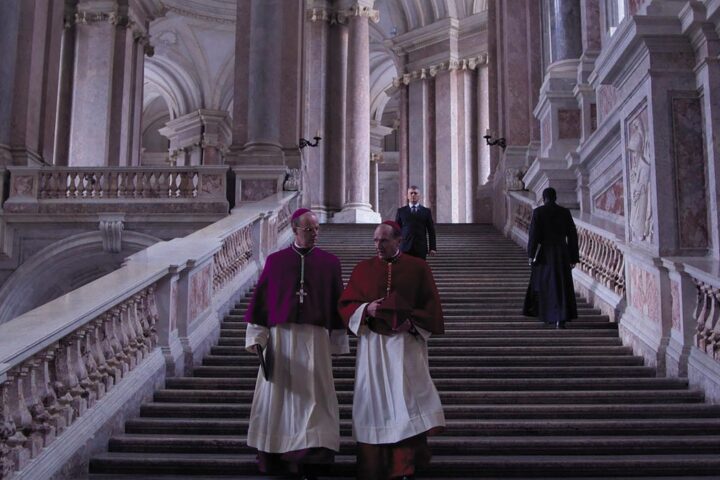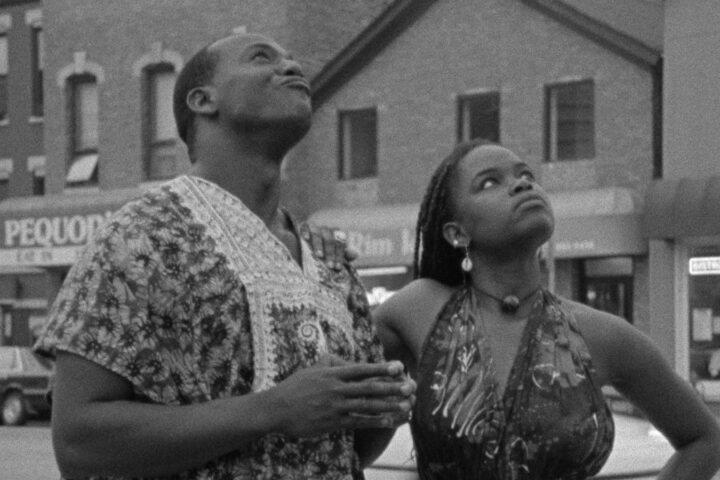It’s quite an accomplishment to segue seamlessly between an Eric André prank video and a high-minded curatorial lecture, and director Kahlil Joseph has made a film in BLKNWS: Terms & Conditions in which a wild jump feels entirely natural. The first feature by the multidisciplinary artist is technically an outgrowth from his video art installation of the same name. Yet this endeavor’s aims feel greater than just adaptation.
Joseph has found a means of polyphonous expression for the intellectual point of origin for his artistic exploration: the Encyclopedia Africana, an expansive compendium of African studies edited by renowned scholars Henry Louis Gates and Anthony Appiah. BLKNWS is a vessel for conveying an eye-popping number of entries that merited inclusion in Gates and Appiah’s survey of Black history, culture, and identity—all of which come annotated with their corresponding page number in the tome. But Joseph quickly expands his remit beyond mere fact recitation to embody the project’s spirit of reclamation and revision.
Joseph models BLKNWS after an album, complete with a 21-item tracklist and featured guest collaborators, among them theater artist Kaneza Schaal, poet Dionne Brand, and video artist Arthur Jafa. (He even visualizes the connection with a spinning vinyl record that bears the film’s title.) Like most albums, there are clear standout tracks, but Joseph introduces such a wide variety of textures throughout that it’s impossible to tune out the more skippable sections.
As he jumps from memes to academic lectures, Joseph grants the same dramatic weight to each section. He also matches this eclectic philosophy in form. Despite the analog visual motif running through the film, Joseph’s method of processing intellectual material marks BLKNWS as a deeply digital work. He disseminates information in an asynchronous and non-linear manner that resembles algorithmic logic. This makes thematic, not just aesthetic, sense considering how central he argues displacement and fragmentation are to the Black experience.
It helps that Joseph is fluent in many different types of storytelling and image-making, and all of his multidisciplinary skills converge in this project. (Joseph’s work ensuring a consistent voice across a sprawling visual album like Beyoncé’s Lemonade is the true guiding light of BLKNWS.) But beyond his usual stock and trade of video art, he trades most cynically in the language of advertising to subvert how Black culture is frequently commodified by capitalist entities without reward or acknowledgment. Joseph also excels at incorporating elements of desktop cinema that reflect the hyperstimulation of synthesizing material received from the internet. He’s more sporadic with the deployment of this stylistic approach, but it always makes an impact.
One area where Joseph stumbles is in his incorporation of narrative segments shot specifically for the film. BLKNWS folds in various sequences of historical recreation as well as other pure fictionalization, and these moments are where the film feels the most leaden. Joseph’s work in music videos is most evident in these sections. In that format, the superimposition of an artist’s track over the images makes them come alive, but when he tries to create meaning organically by leaning on his actors, the dialogue is so mechanically delivered that everything feels stilted.
It’s easy enough, though, to just blow past these speed bumps. After all, BLKNWS zooms across the screen, propelled by the volume and velocity of its ideas, and Joseph embraces the boisterousness of his bold film. Though he can struggle to corral the energy, some of that unwieldiness does feel by design. His hybridized essay film embodies the complications and contradictions inherent within Black history—complete with all its erasures and variances.
Joseph’s tone of curiosity, not certainty, extends a generous hand to all audiences to come explore the vast worlds that he’s conjured. While the film compresses his original two-channel video installation into a single screen, BLKNWS maintains the sprawl of a multimodal experience. He empowers us to construct our version of the film from the exhaustive detail provided because he offers the knowledge as a series of suggestions rather than declarations.
Like contemporaries Garrett Bradley, RaMell Ross, and Ephraim Asili, Joseph acknowledges that the archive of Black images and stories isn’t a fixed object. It lives, breathes, and responds to interaction. By refusing to take the archive at face value in BLKNWS, Joseph frees himself to fill in its gaps with reverence and ribaldry alike. He brings needed imagination and innovation to discussions of how to represent the incongruity and inconsistency within Black history. While Joseph’s newly shot footage might not inspire a fresh entry into the historical record, his overarching aim of reframing materials familiar and unknown inspires deeper engagement.
Since 2001, we've brought you uncompromising, candid takes on the world of film, music, television, video games, theater, and more. Independently owned and operated publications like Slant have been hit hard in recent years, but we’re committed to keeping our content free and accessible—meaning no paywalls or fees.
If you like what we do, please consider subscribing to our Patreon or making a donation.



